
DISCLAIMER: This English version is translated from the original French. In case of any discrepancy, the French version shall prevail.
| Author(s): | Bilodeau, 2022 |
| Age: | Mesoproterozoic |
| Stratotype: | Reference outcrops 2021-CB-1098, 2021-CB-1179, 2021-CB-1075, 2021-CB-1173, 2021-CB-1021, 2021-CB-1191, 2021-CB-1228, 2021-CB-1231 and 2021-CB-1249 |
| Type area: | Île-du-Grand-Calumet (NTS sheet 31F10) |
| Geological province: | Grenville Province |
| Geological subdivision: | Allochton |
| Lithology: | Metasedimentary rocks |
| Category: | Lithodemic |
| Rank: | Complex |
| Status: | Formal |
| Use: | Active |
None
Background
The Outaouais Supracrustal Sequence was introduced by Bilodeau (2022) to group all the metasedimentary rocks mapped in the Île-du-Grand-Calumet area. This unit is related to metasedimentary rocks of the « Grenville Series » (Logan and Hunt, 1855) and the « Grenville Supergroup ». These two units encompass all the rocks of sedimentary and volcanic origin in the « Central Metasedimentary Belt (CMB) », a lithotectonic domain of the Grenvillian Allochton found in Québec, Ontario and the state of New York, in the United States (Wynne-Edward, 1972).
Description
Outaouais Supracrustal Sequence 1 (mPoua1): Silicate calcitic marble, silicate dolomitic marble, pure dolomitic marble, calc-silicate rock, diopsidite
Unit mPoua1 of the Outaouais Supracrustal Sequence groups metasedimentary lithologies derived from carbonate-rich protoliths, such as calcitic marble (mPoua1a) and dolomitic marble (mPoua1b), as well as layers of calc-silicate rock and associated diopsidite (mPoua1c).
Outaouais Supracrustal Sequence 1a (mPoua1a): Silicate calcitic marble, calc-silicate rock
Silicate calcitic marble




 The calcitic marble unit is generally characterized by markeed compositional banding and layers of highly recrystallized calc-silicate rocks. The calcitic marble has a light grey or beige alteration patina and is light grey to beige in fresh exposure. This marble facies is predominantly composed of fine- to medium-grained granoblastic calcite, but may contain a certain percentage of dolomite in places. The rock is characterized by banding defined by concentrations of silicate minerals or locally by alternating fine- to medium-grained grey calcitic bands and coarser beige dolomitic bands. Silicate minerals are estimated to range from 2% to 15%, the main ones being phlogopite (up to 2%) and euhedral diopside in all sizes (up to 3 cm) and colours, varying between translucent grey, grey and dark green. Other minerals observed locally include tremolite, quartz, plagioclase, scapolite, epidote, microcline and hornblende. Calcitic marble locally contains a brownish porphyroblastic mineral in centimetric clusters interpreted as chondrodite. Grossular garnet and wollastonite have also been observed in the Portage-du-Fort area (Katz, 1976). Accessory minerals are pyrite (up to 1%), graphite, titanite and apatite. The fresh surface of samples reacts moderately to strongly with hydrochloric acid.
The calcitic marble unit is generally characterized by markeed compositional banding and layers of highly recrystallized calc-silicate rocks. The calcitic marble has a light grey or beige alteration patina and is light grey to beige in fresh exposure. This marble facies is predominantly composed of fine- to medium-grained granoblastic calcite, but may contain a certain percentage of dolomite in places. The rock is characterized by banding defined by concentrations of silicate minerals or locally by alternating fine- to medium-grained grey calcitic bands and coarser beige dolomitic bands. Silicate minerals are estimated to range from 2% to 15%, the main ones being phlogopite (up to 2%) and euhedral diopside in all sizes (up to 3 cm) and colours, varying between translucent grey, grey and dark green. Other minerals observed locally include tremolite, quartz, plagioclase, scapolite, epidote, microcline and hornblende. Calcitic marble locally contains a brownish porphyroblastic mineral in centimetric clusters interpreted as chondrodite. Grossular garnet and wollastonite have also been observed in the Portage-du-Fort area (Katz, 1976). Accessory minerals are pyrite (up to 1%), graphite, titanite and apatite. The fresh surface of samples reacts moderately to strongly with hydrochloric acid.
Calc-Silicate Rock

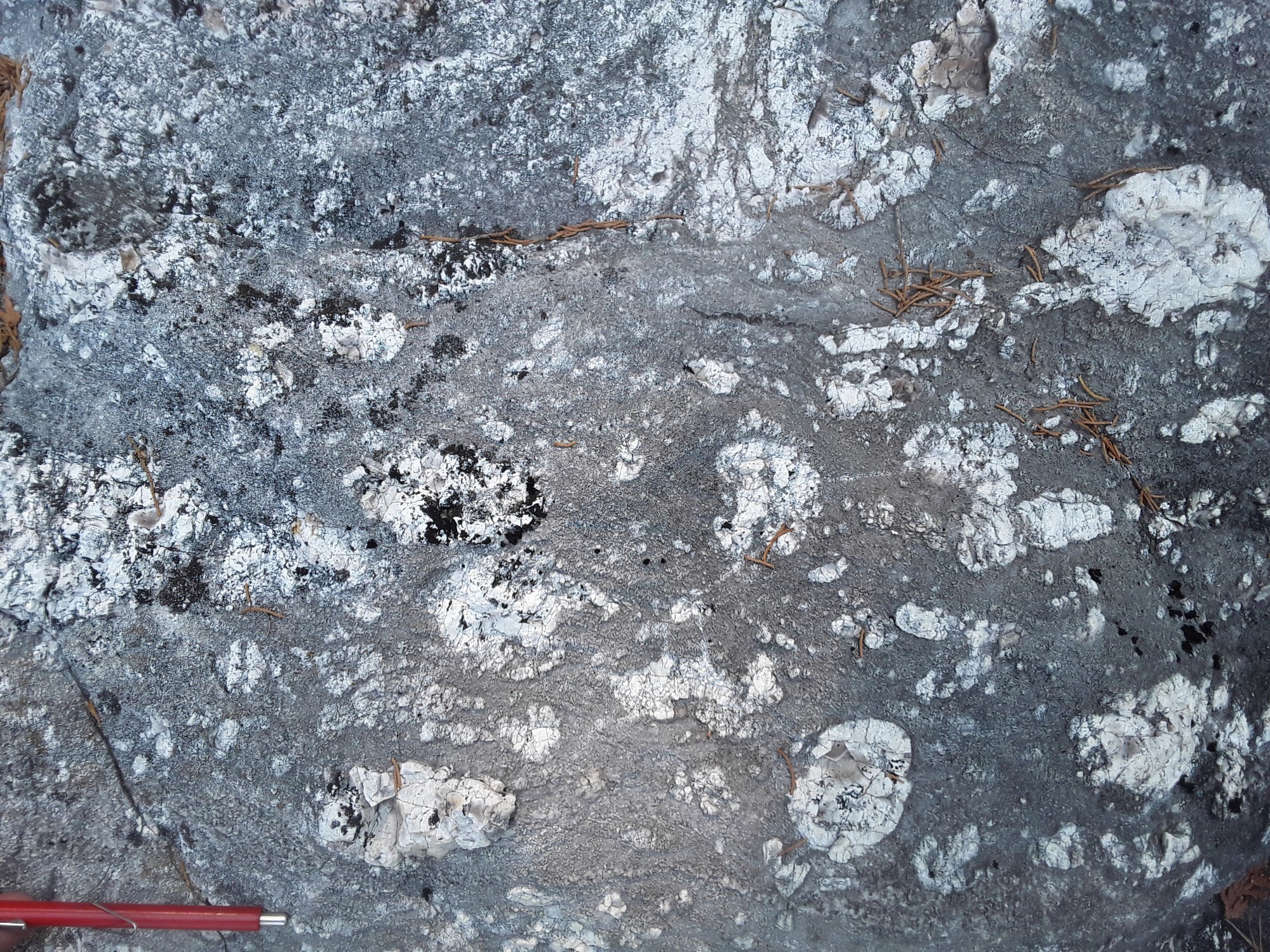 Outcrops of calcitic marble generally contain a variable proportion of very competent calc-silicate rock layers. They are mainly composed of diopside and carbonate, creating a heterogeneous dark green and white mosaic, both on the weathered and fresh surfaces. The main secondary minerals are phlogopite and biotite. Calc-silicate rocks occur in centimetric to c layers, but also as decimetric to metric boudins and centimetric to decimetric nodules in rocks that have undergone more intense deformation.
Outcrops of calcitic marble generally contain a variable proportion of very competent calc-silicate rock layers. They are mainly composed of diopside and carbonate, creating a heterogeneous dark green and white mosaic, both on the weathered and fresh surfaces. The main secondary minerals are phlogopite and biotite. Calc-silicate rocks occur in centimetric to c layers, but also as decimetric to metric boudins and centimetric to decimetric nodules in rocks that have undergone more intense deformation.
Outaouais Supracrustal Sequence 1b (mPoua1b): Silicate dolomitic marble, pure dolomitic marble
Silicate Dolomitic Marble


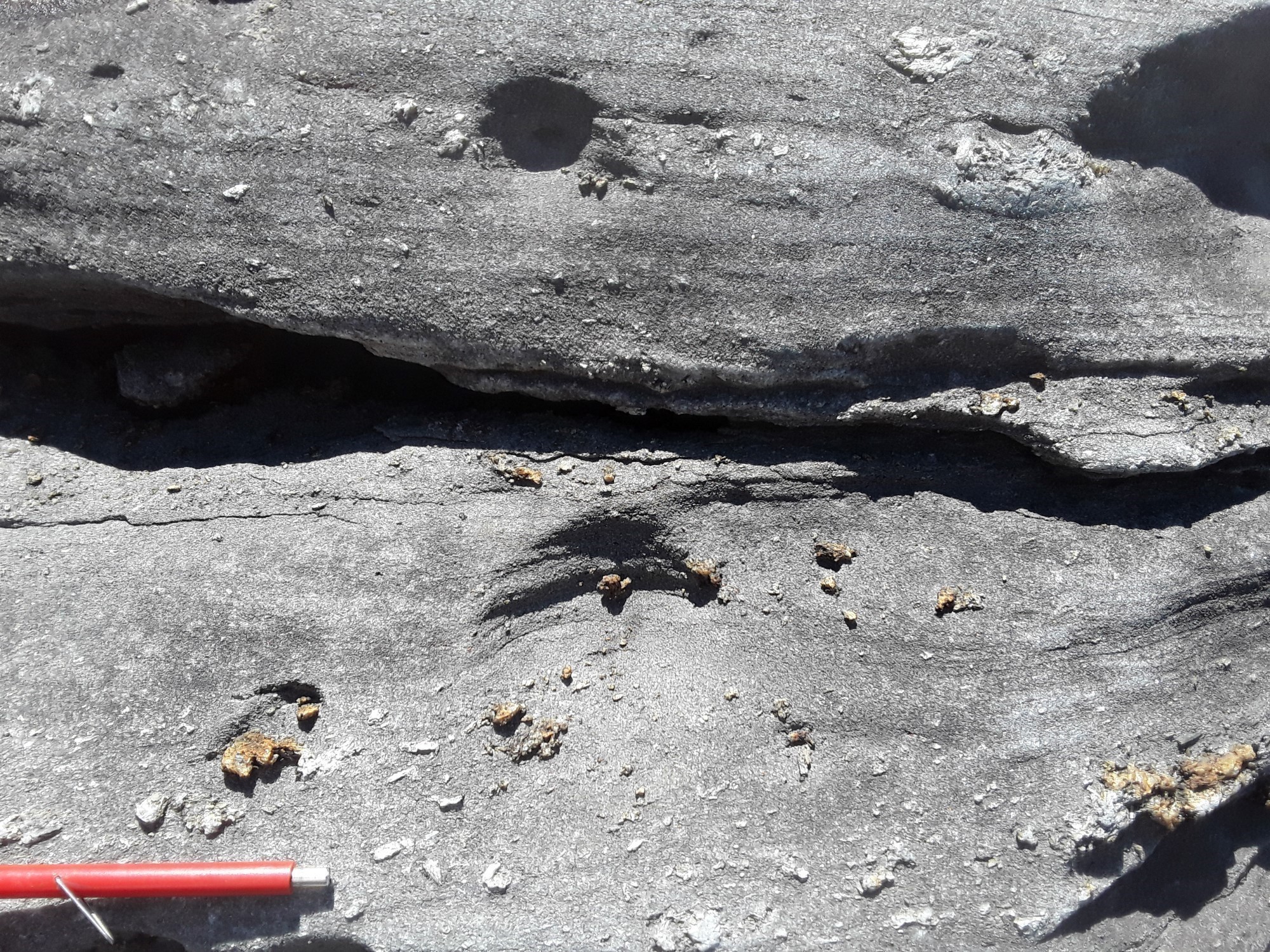 Silicate dolomitic marble is grey, beige or brown in altered patina and light grey or white in fresh surface. This facies consists mainly of fine- to medium-grained dolomite and may contain a certain percentage of calcite in places. Dolomitic marble contains several fine to coarse silicate minerals, most of which are magnesian. They include diopside, phlogopite, tremolite, scapolite, biotite, serpentine, olivine and brucite. These minerals are found either free in the carbonate matrix or in small aligned clusters defining a compositional banding. Accessory minerals include pyrite, magnetite, spinel, and locally zinc-bearing minerals such as sphalerite, willemite, zinc spinel and gahnite (Gauthier and Larivière, 2006). Layers enriched in magnesian silicate typically have a matrix richer in calcite (Moorehouse, 1940). Depending on the percentage of calcite, the rocks may be slightly or not reactive to hydrochloric acid.
Silicate dolomitic marble is grey, beige or brown in altered patina and light grey or white in fresh surface. This facies consists mainly of fine- to medium-grained dolomite and may contain a certain percentage of calcite in places. Dolomitic marble contains several fine to coarse silicate minerals, most of which are magnesian. They include diopside, phlogopite, tremolite, scapolite, biotite, serpentine, olivine and brucite. These minerals are found either free in the carbonate matrix or in small aligned clusters defining a compositional banding. Accessory minerals include pyrite, magnetite, spinel, and locally zinc-bearing minerals such as sphalerite, willemite, zinc spinel and gahnite (Gauthier and Larivière, 2006). Layers enriched in magnesian silicate typically have a matrix richer in calcite (Moorehouse, 1940). Depending on the percentage of calcite, the rocks may be slightly or not reactive to hydrochloric acid.
Pure Dolomitic Marble
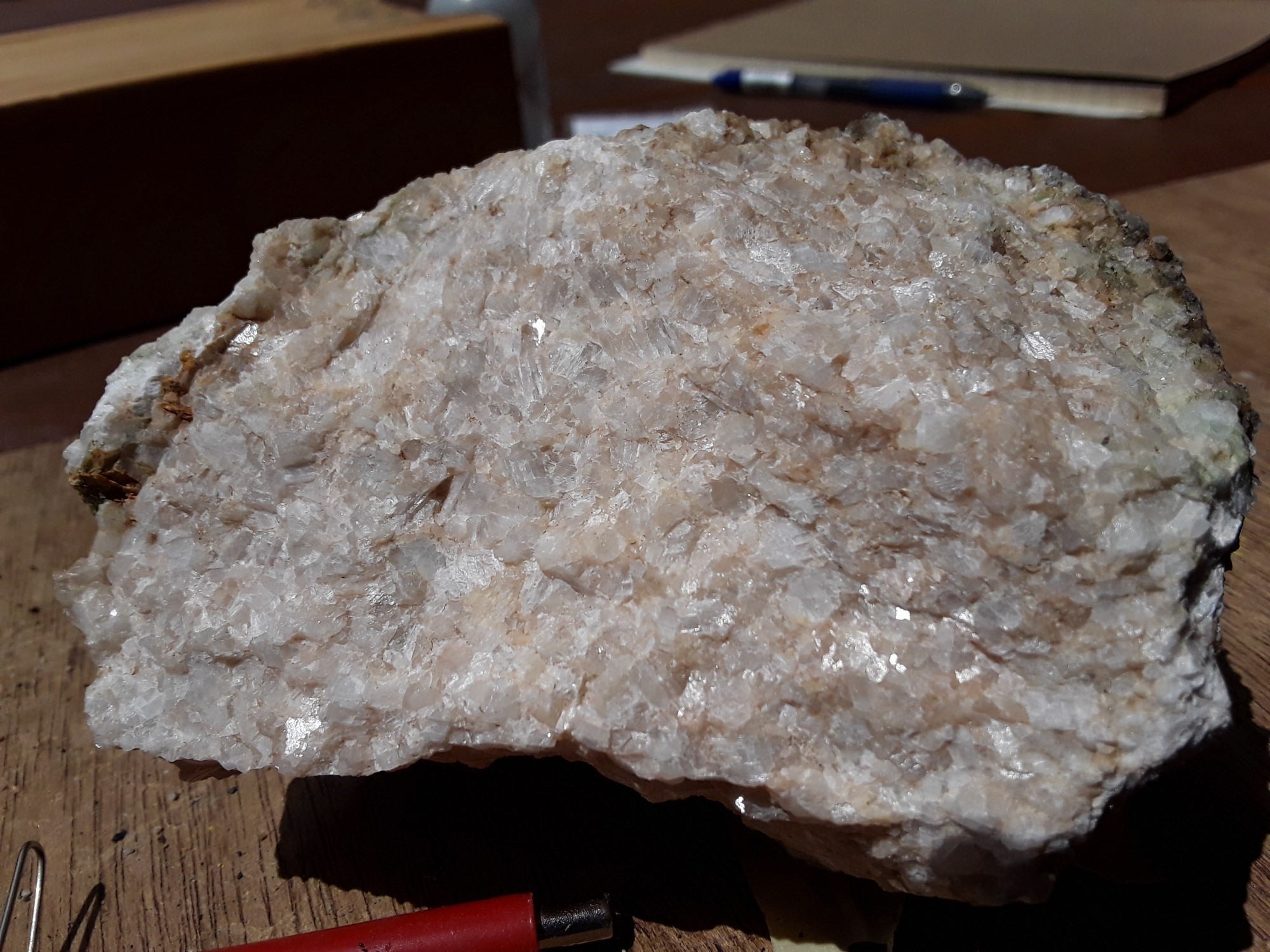 Some of this marble is unique in that it consists almost exclusively of dolomite. It is white in fresh exposure, generally massive and medium- to coarse-grained. The great purity of this facies suggests an evaporitic environment (Gauthier and Larivière, 2006). Preserved meta-evaporites composed of anhydrite have been observed in drilling on the site of the New Calumet Mine (Osborne, 1944). Pure dolomitic marble characteristically releases an odour of hydrogen sulphides when broken (Katz, 1976). This facies does not react with hydrochloric acid.
Some of this marble is unique in that it consists almost exclusively of dolomite. It is white in fresh exposure, generally massive and medium- to coarse-grained. The great purity of this facies suggests an evaporitic environment (Gauthier and Larivière, 2006). Preserved meta-evaporites composed of anhydrite have been observed in drilling on the site of the New Calumet Mine (Osborne, 1944). Pure dolomitic marble characteristically releases an odour of hydrogen sulphides when broken (Katz, 1976). This facies does not react with hydrochloric acid.
Outaouais Supracrustal Sequence 1c (mPoua1c): Diopsidite

 Diopsidite is characterized by a light grey-beige alteration patina and a light grey fresh surface. This lithology appears in positive relief with respect to the marble layers, indicating a contrast in competence between the two lithologies. The unit forms competent layers. This facies is also used as a reference layer to map the Sonny Zinc Mineralized Zone (M. Gauthier, personal communication).
Diopsidite is characterized by a light grey-beige alteration patina and a light grey fresh surface. This lithology appears in positive relief with respect to the marble layers, indicating a contrast in competence between the two lithologies. The unit forms competent layers. This facies is also used as a reference layer to map the Sonny Zinc Mineralized Zone (M. Gauthier, personal communication).
Outaouais Supracrustal Sequence 2 (mPoua2): Banded paragneiss, quartzite
This unit consists of metasedimentary rocks of detrital origin. It mainly contains banded paragneiss, locally including interstratified quartzite layers.
Banded Paragneiss
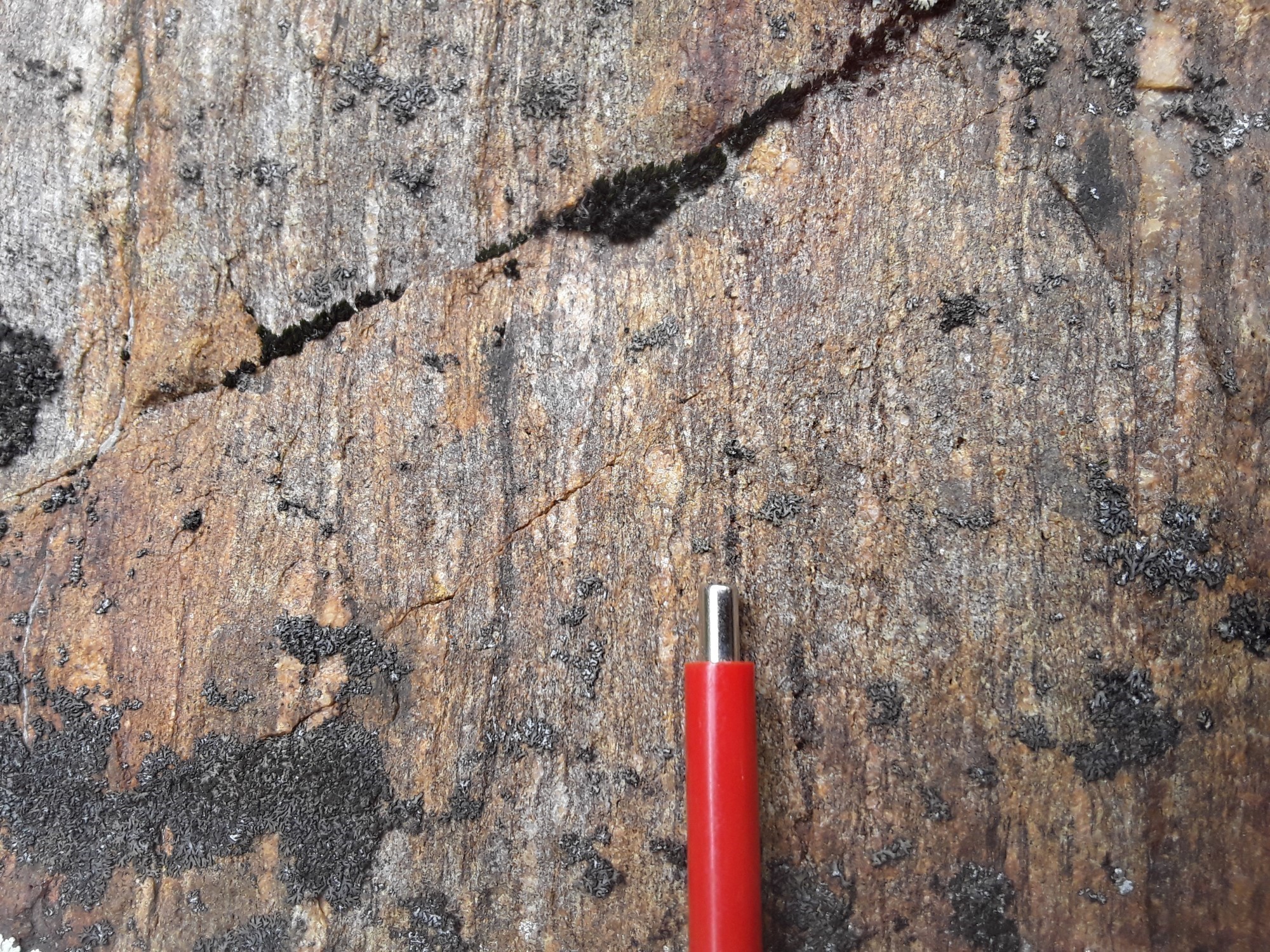
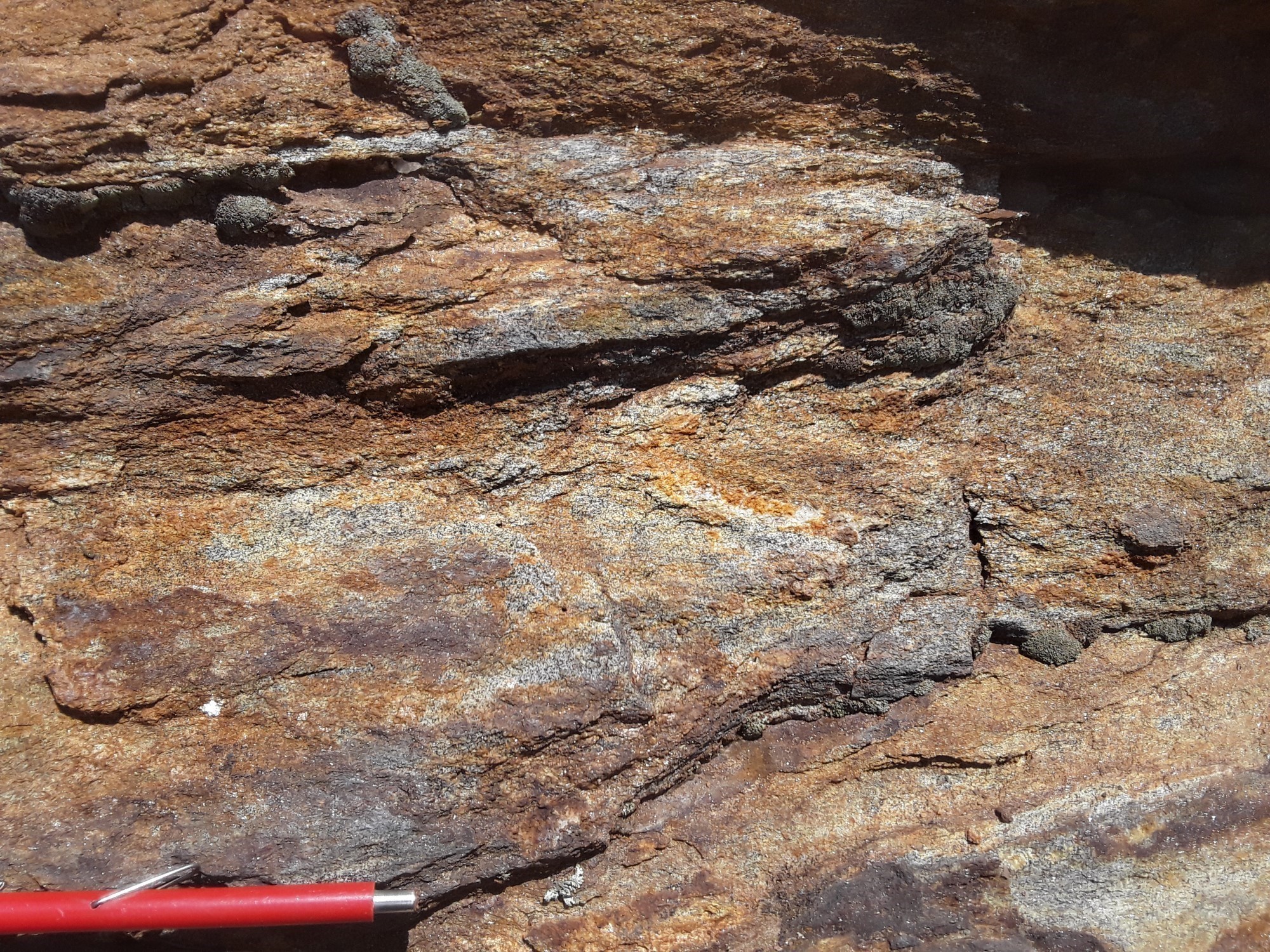




 Paragneiss is light to dark brown, brownish-grey or rusty and grey to dark grey or brownish-grey to yellowish in fresh surface. It is composed of fine- to medium-grained minerals. The rock is generally banded, fairly homogeneous in outcrop and characterized by variations in composition, grain size and structure. The dominant facies takes the form of very quartzose bands alternating with bands richer in feldspar and biotite. Bands enriched in feldspar contain quartz, 35% to 40% fine microcline, 25% to 30% weakly damouritized plagioclase and some biotite. Both quartz and feldspar are finely recrystallized, and the rock locally displays a granoblastic texture. In places, these layers alternate with others containing quartz, carbonate and biotite along with grano-lepidoblastic schist composed of quartz and 30% to 35% coarse biotite. The unit locally features paragneiss facies containing muscovite and staurotide porphyroblasts, but depleted in quartz and sillimanite-biotite schists. Garnet as fine grains or small porphyroblasts has been observed in most of these facies. Sillimanite reaches up to 25% and occurs as crystals oriented within the foliation, arranged in a crown around garnet porphyroblasts, or in clusters with helicitic texture. Secondary minerals observed sporadically include hornblende, centimetric staurotide porphyroblasts, clinopyroxene, hornblende, scapolite and cordierite. Some bands contain 5% to 10% graphite as submillimetric laths oriented within the foliation. Accessory minerals include pyrite, rutile, tourmaline, zircon as biotite inclusion, and magnetite, as evidenced by the high magnetic susceptibility in some bands.
Paragneiss is light to dark brown, brownish-grey or rusty and grey to dark grey or brownish-grey to yellowish in fresh surface. It is composed of fine- to medium-grained minerals. The rock is generally banded, fairly homogeneous in outcrop and characterized by variations in composition, grain size and structure. The dominant facies takes the form of very quartzose bands alternating with bands richer in feldspar and biotite. Bands enriched in feldspar contain quartz, 35% to 40% fine microcline, 25% to 30% weakly damouritized plagioclase and some biotite. Both quartz and feldspar are finely recrystallized, and the rock locally displays a granoblastic texture. In places, these layers alternate with others containing quartz, carbonate and biotite along with grano-lepidoblastic schist composed of quartz and 30% to 35% coarse biotite. The unit locally features paragneiss facies containing muscovite and staurotide porphyroblasts, but depleted in quartz and sillimanite-biotite schists. Garnet as fine grains or small porphyroblasts has been observed in most of these facies. Sillimanite reaches up to 25% and occurs as crystals oriented within the foliation, arranged in a crown around garnet porphyroblasts, or in clusters with helicitic texture. Secondary minerals observed sporadically include hornblende, centimetric staurotide porphyroblasts, clinopyroxene, hornblende, scapolite and cordierite. Some bands contain 5% to 10% graphite as submillimetric laths oriented within the foliation. Accessory minerals include pyrite, rutile, tourmaline, zircon as biotite inclusion, and magnetite, as evidenced by the high magnetic susceptibility in some bands.
The paragneiss is characterized by numerous millimetre- to centimetre-sized interfoliar veinlets of light grey to black recrystallized quartz. There are also local sills of tourmaline and muscovite granite, concordant to subconcordant with the foliation. They are interpreted as different families of mobilisate injections resulting from the partial melting of paragneiss (Madore et al., 1994).
Quartzite

 Quartzite occurs as light grey decimetric to metric bands interstratifed with paragneiss bands. The rocks are composed of fine to medium granoblastic quartz, exhibiting marked undulatory extinction under the microscope and complex, indented crystalline faces. Plagioclase and K-feldspar account for <10% of the volume of the rock; small garnets, biotite, diopside, graphite and sillimanite are present locally (Madore et al., 1994). Accessory minerals include titanite, apatite and zircon.
Quartzite occurs as light grey decimetric to metric bands interstratifed with paragneiss bands. The rocks are composed of fine to medium granoblastic quartz, exhibiting marked undulatory extinction under the microscope and complex, indented crystalline faces. Plagioclase and K-feldspar account for <10% of the volume of the rock; small garnets, biotite, diopside, graphite and sillimanite are present locally (Madore et al., 1994). Accessory minerals include titanite, apatite and zircon.
Thickness and Distribution
The Outaouais Supracrustal Sequence covers almost 50% of the surface area of the Île-du-Grand-Calumet area (sheet 31F10). This area is distinguished by the abundance of dolomitic-facies carbonate rocks, while calcitic marble clearly predominates in the CMB metasedimentary rock suite (Gauthier and Larivière, 2006). Quartzite and paragneiss are also particularly scarce in the area (Osborne, 1944). These lithologies appear to be more abundant in the southern half of the Île-du-Grand-Calumet area, and are especially associated with calcitic marble. Terrigenous rock layers are less abundant in the dolomitic marble of the northern part of the area.
The thickness of the unit cannot be estimated, as the stratigraphy of these rocks is unknown. In addition, the particular plastic nature of carbonate rocks facilitated their lateral mobilization during orogenic episodes. For example, this phenomenon generated local lithological thickening, particularly in the case of pure dolomitic marble in the fold hinges of the Portage-du-Fort area.
Dating
Isotopic dating of a sample from outcrop 2021-CB-1238 revealed a Mesoproterozoic detrital age.
| Unit | Sample Number | Isotopic System | Mineral | Detrital Age (Ma) | (+) | (-) | Metamorphic Age (Ma) | (+) | (-) | Reference(s) |
| mPoua2 | 2021-CB-1238B | U-Pb | Zircon | 1203 | 7 | 7 | Davis, 2023 | |||
| Titanite | 1091 | 12 | 12 |
Stratigraphic Relationship(s)

 The geological map of Île-du-Grand-Calumet does not provide an absolute stratigraphy for this unit, since the carbonate and terrigenous lithologies are of unknown polarity. The same applies to the stratigraphy of calcitic and dolomitic marbles. The magnesian character of marble is possibly the result of regional dolomitization of hydrothermal origin subsequent to the deposition of sediments. This hypothesis has been proposed as a syntectonic vector for zinc-bearing mineralization in dolomitic units during the Acadian orogeny in the Gaspésie region (Berger, 2001).
The geological map of Île-du-Grand-Calumet does not provide an absolute stratigraphy for this unit, since the carbonate and terrigenous lithologies are of unknown polarity. The same applies to the stratigraphy of calcitic and dolomitic marbles. The magnesian character of marble is possibly the result of regional dolomitization of hydrothermal origin subsequent to the deposition of sediments. This hypothesis has been proposed as a syntectonic vector for zinc-bearing mineralization in dolomitic units during the Acadian orogeny in the Gaspésie region (Berger, 2001).
According to the geochronological data available, rocks of the Outaouais Supracrustal Sequence host the main intrusive units in the Île-du-Grand-Calumet area, including the eldest, the Schwartz Intrusive Suite, dated at 1254 ±20 Ma (Davis, 2023). Enclaves of carbonate rocks recorded in this unit suggest that the supracrustal sequence forms the bedrock in the region. The metasedimentary rocks are also older than the metavolcanic rocks, since it was established that the dolomitic marble in the vicinity of the New Calumet deposit structurally underlies amphibolite of the Grand-Calumet Complex (Gauthier, 2019).
Paleontology
Does not apply.
References
Publications available through SIGÉOM Examine
BERGER, J., CLARK, J., 2001. Dolomitisation et minéralisations en plomb/zinc de type vallée du Mississippi de l’est de la Gaspésie et leur relation avec les indices d’hydrocarbures. assessment work submitted to the Governement of Québec; GM 59448, 622 pages, 4 plans.
BILODEAU, C. 2022. Géologie de la région de l’Île-du-Grand-Calumet, Province de Grenville, Outaouais, Québec, Canada. MERN; BG 2022-07, 1 plan.
DAVIS, D.W., 2023. Rapport sur les datations U-Pb de roches du Québec 2021-2022. MRNF; MB 2023-02
GAUTHIER, M., 2019. Rapport des travaux effectués à l’automne 2017 sur la propriété Calumet-sud. SOQUEM INC, RESSOURCE SPHINX LTÉE, assessment work submitted to the Governement of Québec; GM 71569, 30 pages.
GAUTHIER, M., LARIVIERE, J. F., 2006. Minéralogie et propriétés géophysiques des gîtes de zinc disséminé dans les marbres du Supergroupe de Grenville – volet minéralogie du zinc non-sulfuré, assessment work submitted to the Governement of Québec; GM 62901, 14 pages.
KATZ, M. B., 1976. Région Portage-du-Fort et lac Saint-Patrice. MRN; RG 170, 135 pages, 1 plan.
MADORE, L., GLOBENSKY, Y., SHARMA, K. N. M., 1994. Synthèse géologique de la région de Fort-Coulonge, SNRC 31F. MRN; MB 94-39, 27 pages, 1 plan.
MOOREHOUSE, W. W., 1940. Report on the lead-zinc deposits. assessment work submitted to the Governement of Québec; GM 10442, 13 pages.
OSBORNE, F. F., 1944. Région de l’île Calumet, comté de Pontiac. MRN; RG 018, 36 pages, 2 plans.
OSBORNE, F. F., 1944. Calumet island area, Pontiac county. MRN; RG 018(A), 36 pages, 2 plans.
Other publications
LOGAN, W.E., HUNT, T.S., 1855. Esquisse géologique du Canada pour servir à l’intelligence de la carte géologique et de la collection des minéraux économiques envoyées à l’Exposition universelle de Paris, 1855. Commission géologique du Canada; Rapport séparé no. 395, 1855, 100 pages, 1 feuille. https://doi.org/10.4095/216056
WYNNE-EDWARDS, H.R., 1972. The Grenville Province. In: Variations in tectonic styles in Canada. Edited by R.A. Price and R.J.W. Douglas. Geological Association of Canada; Special Paper 11, pages 263-334.
Suggested Citation
Ministère des Ressources naturelles et des Forêts (MRNF). Outaouais Supracrustal Sequence. Québec Stratigraphic Lexicon. https://gq.mines.gouv.qc.ca/lexique-stratigraphique/province-de-grenville/complexe-des-outaouais_en [accessed on Day Month Year].
Contributors
|
First publication |
Carl Bilodeau, P. geo., M.Sc. carl.bilodeau@mrnf.gouv.qc.ca (redaction) Céline Dupuis, P.Geo., Ph.D. (coordination); Abdelali Moukhsil, P.Geo., Ph.D. (critical review); Simon Auclair, P.Geo., M.Sc. (editing); Catherine Tremblay (English version). |

